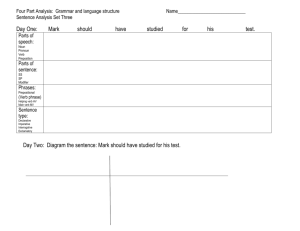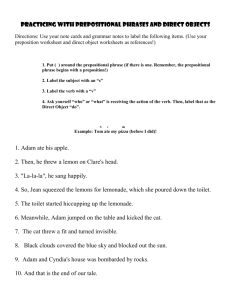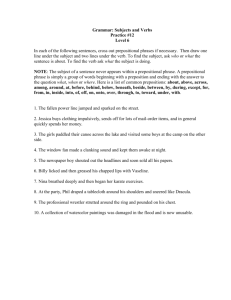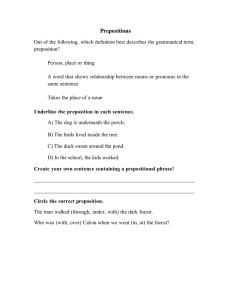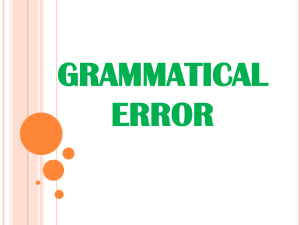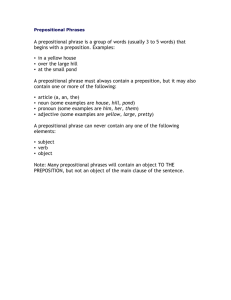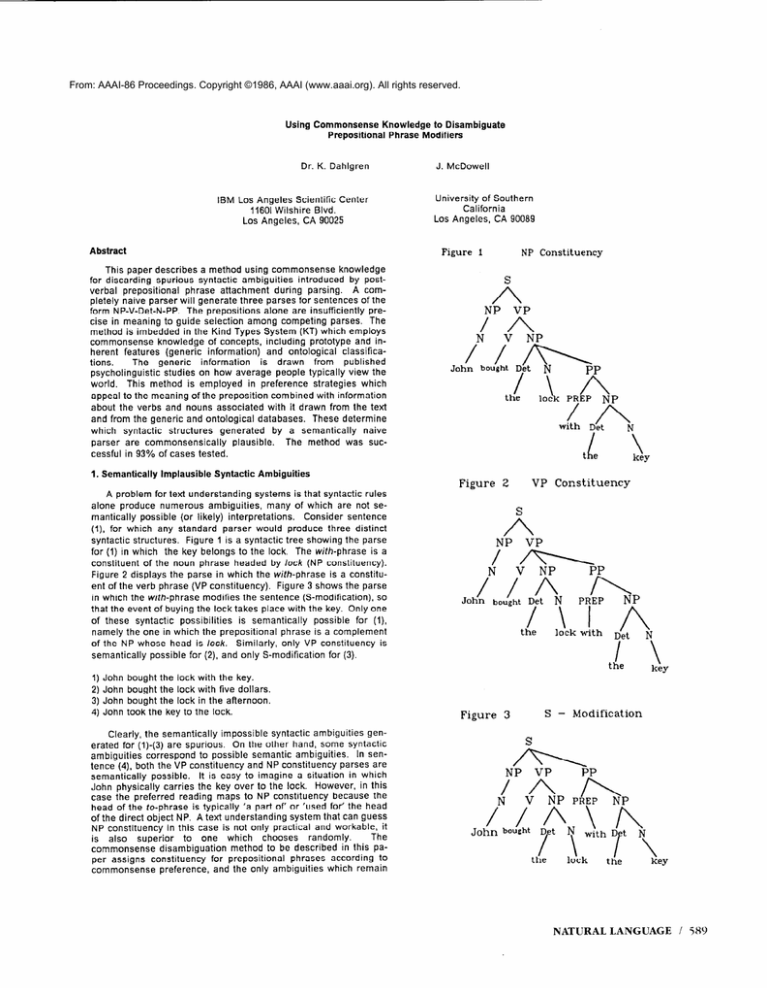
From: AAAI-86 Proceedings. Copyright ©1986, AAAI (www.aaai.org). All rights reserved.
Using Commonsense
Knowledge to Disambiguate
Prepositional Phrase Modifiers
Dr. K. Dahlgren
IBM Los Angeles Scientific
Center
11601 Wilshire Blvd.
Los Angeles,
CA 90025
J. McDowell
University
of Southern
California
Los Angeles,
CA 90069
Figure
Abstract
This paper describes
a method using commonsense
knowledge
for discarding
spurious
syntactic
ambiguities
introduced
by postverbal
prepositional
phrase
attachment
during
parsing.
A completely naive parser will generate
three parses for sentences
of the
form NP-V-Det-N-PP.
The prepositions
alone are insufficiently
precise in meaning to guide selection
among competing
parses.
The
method is imbedded
in the Kind Types System (KT) which employs
commonsense
knowledge
of concepts,
including
prototype
and inherent
features
(generic
information)
and ontological
classificaThe
generic
information
is drawn
from
published
tions.
psycholinguistic
studies on how average
people typically
view the
world.
This method
is employed
in preference
strategies
which
appeal to the meaning of the preposition
combined
with information
about the verbs and nouns associated
with it drawn from the text
and from the generic and ontological
databases.
These determine
which
syntactic
structures
generated
by a semantically
naive
parser
are commonsensically
plausible.
The method
was successful in 93% of cases tested.
1. Semantically
Implausible
Syntactic
1
NP Constituency
S
A
NP
/
i
John
VP
A
7
JK
bought Det
th!!
,I
Figure
A problem for text understanding
systems is that syntactic
rules
alone produce
numerous
ambiguities,
many of which are not semantically
possible (or likely) interpretations.
Consider
sentence
(l), for which any standard
parser would produce
three distinct
syntactic
structures.
Figure 1 is a syntactic
tree showing the parse
for (1) in which
the key belongs to the lock. The with-phrase
is a
constituent
of the noun phrase headed by lock (NP constituency).
Figure 2 displays the parse in which the with-phrase
is a constituent of the verb phrase (VP constituency).
Figure 3 shows the parse
in which the with-phrase
modifies the sentence
(S-modification),
so
that the event of buying the lock takes place with the key. Only one
of these
syntactic
possibilities
is semantically
possible
for (l),
namely the one in which the prepositional
phrase is a complement
of the NP whose head is lock.
Similarly,
only VP constituency
is
semantically
possible for (2), and only S-modification
for (3).
1) John
bought
the lock with the key.
bought
bought
the lock with five dollars.
the lock in the afternoon.
4) John took the key to the lock.
PRE&Np
/A
with
Ambiguities
2) John
3) John
N
VP
2
NP
/
Figure
Det
N
Constituency
VP
-
3
S-
Modification
Clearly, the semantically
impossible
syntactic
ambiguities
genOn the other hand, some syntactic
erated for (l)-(3) are spurious.
ambiguities
correspond
to possible semantic
ambiguities.
In sentence (4), both the VP constituency
and NP constituency
parses are
semantically
possible.
It is easy to imagine
a situation
in which
John physically
carries the key over to the lock.
However,
in this
case the preferred
reading maps to NP constituency
because the
head of the to-phrase
is typically
‘a part of’ or ‘used for’ the head
of the direct object NP. A text understanding
system that can guess
NP constituency
in this case is not only practical
and workable,
it
The
superior
to
one
which
chooses
randomly.
is also
commonsense
disambiguation
method to be described
in this paper assigns
constituency
for prepositional
phrases
according
to
commonsense
preference,
and the only ambiguities
which remain
NATURAL
LANGUAGE
/ 589
after the preference
strategy has been invoked are the semantically
such as those in (5).
and corn monsensically
possible ambiguities,
1985) , which differ in employing
and Schmolze,
which are richer than first order log ic.
5) John saw the man in the park.
John built the houses by the sea.
In addition
to a standard
syntactic
lexicon,
KT employs
commonsense
knowledge
encoded
in PROLOG axioms in several
databases.
The Ontological
Database
encodes
basic distinctions
The
Generic
Lexicon
lists
such
as REAL
vs ABSTRACT.
prototypical
and inherent features of nouns and verbs. The Feature
Typing Database
classifies
features as colors, etc. The Kind Types
Database
lists constraints
on feature
types associated
with kind
types such as persons, artifacts,
etc.
(l)-(4) are all of the form NP-V-NP-PP.
The same considerations
apply when there are multiple
PPs. Consider
sentence
(6), which
has eight parses, of which only one is semantically
possible (to the
pasture is a VP constituent,
and in the afternoon
modifies the S).
6) The boy took the cow to the pasture
2. Using Commonsense
Knowledge
in the afternoon.
to Disambiguate
One solution
to the problem
of spurious
ambiguities
is
semantically-driven
parsing, which forces you to give up the speed
and parsimony
of autonomous
parsing (Arens, 1981, Wilks, 1985).
Another
solution
is to ask the user to disambiguate,
as in Tomita
(1985). This works well in the database
querying
environment,
but
not for text understanding,
where human intervention
is not feasible. A third possibility,
to be described
here, is to use the knowledge already
needed to understand
the text to eliminate
spurious
parses.
Exemplifying
the method with sentences
(1) - (3), in (l), the
with-phrase
must be a NP constituent
because locks typically
have
keys.
English speakers
know this, and that is why (1) is unambiguous.
In (2), the with-phrase
is a VP constituent
because buy is a
verb of exchange.
In (3), the fact that afternoon
is a temporal
noun
forces the interpretation
in which the PP modifies
the S because
only events have a temporal
argument.
The method described
here uses commonsense
knowledge
associated
with concepts
to choose
among
possible
parses
for a
sentence
with a prepositional
phrase
to the right of the verb.
(Prepositional
phrases
in the subject of the sentence
are not ambiguous in the same way, because PPs after the head of the subject
noun must be NP constituents.
We assume that preposed
PPs as
in “In the spring, we go dancing” show up at the end of the S after
parsing.)
A text understanding
system
can eliminate
spurious
parses by employing
preference
strategies
in the spirit of Warren
(1981).
The disambiguation
method is independent
of the type of
parser and grammar.
After each parse is generated,
and before
semantic
interpretation,
word-level
commonsense
knowledge
is
employed
to decide whether the parse is preferred.
The knowledge
used here derives from empirical
psycholinguistic
studies of prototypes associated
with common
nouns and with verbs (Rosch et al,
1976, Graesser,
1985, Ashcraft,
1976, Dahlgren,
1985). In order to
make the system seem to understand
the text, this knowledge
is
needed anyway
(Hayes 1985, Hobbs et al, 1985, Lenat et al, 1986).
We
found
that
in
limited
text
understanding,
where
the
grammaticality
of the text can be assumed, the level of detail called
for in Waltz (1981), Gawron
(1982), and Herskovits
(1985) is not
necessary.
This paper will first outline the text understanding
system and
its use of commonsense
knowledge,
then describe
how this knowledge is used in preference
strategies
for prepositional
ambiguities,
and finally list the preference
strategy
rules and discuss their implementation.
The Ontological
Database
reflects top-level
category
cuts in
commonsense
knowledge.
It is an original
cross-classification
scheme, taking into account previous work (Keil, 1979, Tenenbaum,
1985). The ontology
is represented
as PROLOG axioms, and every
common
noun and verb which KT recognizes
is attached at one of
its leaves in a rule like (7). Using ontological
information,
the KT
system
deduces
taxonomically
inherited
information
about the
sorts mentioned
in the text, as described
below.
The Generic
Lexicon
contains
prototypical
and inherent
features of common
nouns which are taken from empirical
studies of
prototypes.
The entry for chicken is shown in (8). The first argument is a list of prototype
features,
and the second a list of inherent
features.
(7)
bird(X)
(8)
chicken{
Knowledge
/ SCIENCE
{ white.scratch(X).farm.
meat.eggs.roost(X)
} ,
The features
with variables
are logic translations
of verb phrases.
The Feature Typing database
types every feature
which occurs in
the Generic Lexicon as a color, size, behavior,
function,
and so on.
Thirty-three
feature types account for all of the features.
The text in (9) is representative
syntax KT works with.
of the range
9) John is a miner who lives in a small town.
John raises a chicken which lays brown eggs.
of vocabulary
John
digs
and
for coal.
The text is translated
into PROLOG axioms to form a Textual
Database.
Queries
to the system
are translated
into PROLOG
goals.
Queries are answered
by a problem solver which consults
the Textual,
Ontological,
Generic
and Typing
databases.
For a
higher-level
question such as “What color is the coal?“, KT finds the
generic
information
for coal (by Prolog predicate
matching).
Then
it compares
all the colors in the Feature Typing Database to the list
of generic features
and finds that “black” is an inherent
feature of
coal.
For a lower-level
question,
such as “Is the coal black?“, only
the generic information
is accessed.
The system identities
higherlevel questions
by looking at a list of higher-level
predicates
(the
types).
The answers
to queries
can come from any of these
sources, as illustrated
in (10).
Database
in the Kind Types System (KT)
The Kind Types (KT) system (Dahlgren
and Mcdowell,
1986) is
written
in VM/PROLOG.
KT reads
geography
text
using
an
IBM-internal
parser and logic translator
(Stabler & Tarnawsky),
and
partially
understands
it because of commonsense
knowledge
in its
Ontology
and Generic Lexicon.
It can answer queries both of what
the text says directly,
and of information
the typical
speaker
of
English would infer from the text because of commonsense
knowledge.
KT’s representations
are based upon a theory which identifies lexical meaning
with commonsense
knowledge
of concepts,
so that there is no difference
in form of representation
between
word meanings
and encyclopedic
knowledge.
This theoretical
basis is shared with other approaches
such as KL-ONE (Brachman
590
+ chicken(X).
{ lay(X,Y) & egg(Y).handleable.
haspart(legs,2).cluck(X)
} ).
(10) Textual
3. Commonsense
representations
Is John a miner?
-- Yes
Where does John
-- In a small town
Ontological
live?
Database
What is a miner?
- A miner is a role, sentient,
concrete,
social, individual,
real, and an entity.
What is digging?
-- A motion, goal oriented,
temporal,
individual,
and real.
Generic
4.2 Ontological
Database
Much less crucial is information
about the ontological
class of
the DO. As described
above, the fact that a DO is PROPOSITIONAL
is important
only in the case of two classes of prepositional
objects
and then only for certain
prepositions.
If the DO is a MEASURE,
then the PP is an NP constituent
(enough food for their needs, much
about the world).
Is the miner rugged?
--Probably
so.
Does the chicken lay eggs?
-Inherently
so.
Does John use a shovel?
-Probably
so.
4.3 Ontological
Typing and Generic
Commonsense
Knowledge
used in the Preference
Strategy
Our preference
strategy
assigns
PP constituency
according
to
information
from several
sources:
syntactic
information
about the
preposition
(PREP)
and
the
verb
(V); information
from
the
Ontological
Database
about the V, direct object (DO), and object of
the preposition
(POBJ); and information
from the Generic Database
about the V, DO and POBJ. Table 1 lists the preference
rules preposition by preposition.
4.1 Ontological
Class of Object of the Preposition
While it is possible
for the POBJ to belong to any ontological
class, membership
in a small set of such classes
restricts
the
PP-assignment
possibilities
for many prepositions.
For example,
If the POBJ is temporal,
in the morning,
the PP modifies
the S.
for six days
If the Prep is by, the POBJ
the PP modifies the NP.
the book
is sentient
and the DO is propositional,
by Chomsky
If the Prep is at or in and the POBJ is abstract,
S.
the PP modifies
the
the PP modifies
the
at once, in detail
If the Prep is on, and the POBJ is propositional,
NP.
the book
on love
Sometimes
it is necessary
to consider
not only the ontological
class of the object of the preposition,
but also the ontological
class
of the DO. For example,
in the report by the committee
it is necessary to know not only that report
is PROPOSITIONAL,
but that
committee
is SENTIENT.
Other ontological
classes which play a
role in the preference
strategies
are PLACE, EMOTION,
ROUTE,
MEASURE,
RELATION,
and DIRECTION.
A global
rule assigns
locative
and directional
PPs to the VP as in (ll), though later specific prepositional
rules may assign them as as S modifiers
if the
global rule fails as in (12).
11) John
12) John
Class of Verb
Databases
What color is the coal?
--Typically
black.
What size is the chicken?
--Inherently
handleable.
4.
Class of The Direct Object
put the book in the living room.
read the book in the living room.
PLACES can be social places (factory, hospital)
or natural places
(valley, mountain).
EMOTIONS
enter into PPs in such phrases as
under duress, in fear, from hatred, with courage,
etc. ROUTES are
terms like way, road, path.
MEASURES appear in PPs with to (to a
degree,
to a point).
DIRECTIONS
figure prominently
in physical
descriptions
(to the North, on the South).
PPs headed by with and
without
are NP constituents
if the DO is a RELATION (connection
with, contact with).
The nature of the verb itself can sometimes
induce a preference
for a PP assignment
without
reference
to any other information.
For instance,
the verbs
be and stand
and other
intransitive
STATIVES like them automatically
take any PP as a VP constituent
(be on time, stand in the rain).
For this reason the global rule for
statives
must
precede
the global
rule assigning
all temporal
phrases
as S modifiers.
Mental verbs
force VP constituency
for
PPs headed by of, for, and about (Gawron,
1982), as illustrated
by
(13) as opposed to (14).
13) John thought of his sweetheart
while
14) John repaired the roof of the house.
he waited.
Verbs of exchange,
such as buy, typically take three arguments,
object exchanged,
the source, and the goal.
In addition,
the
and the benefactee
of the exchange
can be
dium of exchange
pressed.
With such verbs, PPs headed by for, from, and with,
VP constituents.
4.4 Generic
the
meexare
Information
So far just the ontological
classification
of the verb and the NPs
to its right have been considered.
The Generic Database
was encoded originally
in order to describe prototypical
and inherent
features of objects for purposes of understanding
the meaning of text.
It was found to be useful as well in addressing
the problem of PP
attachment.
The generic relations
between nouns illustrated
in this
section
are encoded
in the Generic
Database
for nouns.
In the
case of with and on it is sufficient that the POBJ is mentioned
in the
prototype
description
for the DO (car with a wheel,
birds with
feathers, hair on the head).
A locative
relationship
can also be part of generic information.
A stove is typically
in the kitchen, a book on a shelf, etc. The typical
MATERIAL
from which an object is made is included in the generic
informatlon
for physical
objects.
A house is made from wood, a
window
from glass.
We call SOLVERS the nouns which are typically associated
with other nouns by means of to (the key to the
lock, the answer to the probiem).
SIZE is a generic feature and is
encoded
in terms
of 13 reality-related
size ranges
which
have
mnemonic
names such as microscopic,
person-sized,
etc. An object must be of the order of at least two sizes larger than the subject of a sentence
in order for it to be a suitable
location
for an
action by the subject.
That is, a PP headed by a locative
preposition will be a S modifier
if the prepositional
object is a suitable
location for the action of the subject as in (15) and otherwise
it will
be a VP or NP constituent
as in (16).
15) John
16)John
mixed
mixed
the salad
the salad
in the kitchen.
in the salad bowl.
The relation
between
a verb and the generic
INSTRUMENT
with
which the verbal action
is carried out is encoded
in the Generic
Database
for verbs
along
with
other
information,
such
as
selectional
restrictions
on verb arguments.
In (17), because knife
is a typical INSTRUMENT
for the verb cut, the PP is assigned to the
VP, but it is assigned to the S in (18).
17) John
18) John
cut the loaf with
cut the loaf with
a knife.
glee.
NATURAL
LANGUAGE
/ j9 1
4.5 Syntax
Certain syntactic
constructions
can also force PP interpretation.
There is a large class of intransitive
verbs which are ill-formed
unless accompanied
by certain
prepositions
(depend
on, look for,
make up, get along with, revolve about, cooperate
with, turn to, divide into, provide
for).
These are conventional
co-occurrence
requirements,
and they force the PP to be interpreted
as a VP
constituent.
Adjectives
+ PP require attachment
to the phrase (XP)
containing
the adjective
(suitable
for a child, useful for parsing).
On the other
hand,
the comparative
construction
forces
NP
constituency
(the largest book in the library, uglier than the man at
the desk).
We showed above that the ontological
class of the POBJ can
determine
correct PP constituency.
Generics
and names are syntactic classes and also guide PP parsing.
19) John
20) John
read the book on Peter the Great.
read the book on dogs.
For each preposition
there is a general rule which takes effect
when all the specific rules fail. This is a kind of Elsewhere
Condition for the syntax of prepositions.
Generalizing
the results of the
study, locative
PPs are NP constituents;
directional
PPs are VP
constituents;
and time/manner/place
PPs are S modifiers.
However, whether
or not a PP falls into one of these classes is a function of the prepositional
head in combination
with the verb and the
prepositional
object and not of the preposition
alone.
5. Success
Rate of the Preference
Strategy
The PP rules were developed
intuitively
by considering
the
interaction
of each preposition
with one, two and three-place
verbs.
Then the PP rules were hand-tested
on 4500 words of schoolbook
geography
texts, the original
corpus upon which the lexicon
and
ontology
in the KT system were built.
The PP-attachment
rules
were developed
independently
of these texts, but the success rate
was a surprising
100%. Then, as a check against these results, the
rules were hand-tested
on a second group of three short sample
texts,
These were {l) a 461-word
excerpt
from a novel, (2) a
415-word excerpt from a work on the history of science,
and (3) a
409-word
excerpt
from a technical
article.
We assumed
parser
translation
of the texts into strings of the form NP-V-NP-PP for submission to our rules. We also ignored passive by-phrases
because
the parser recognizes
them as distinct from ordinary
PPs. On the
latter three texts the rules were tested as if the vocabulary
was
resident
in our system.
The overall
success
rate for the second
group is 93%. The failures in these tests are of two types. The first
type of failure was in idiomatic
phrases,
most of which have the
function
of asides or sentence
qualifiers
(at all, in effect, in every
case, under my eyes, in particular,
according
to). We do not view
this as a defect in our system
since any system
must be able
eventually
to deal with idiomatic
phrases.
The second type of failure was outright
failure of the rules.
If we ignore the failures due
to idiomatic
phrases then the average success rate for the second
group is much higher, 98%.
One reason why the success rate is
so high is the high occurrence
rate of of-phrases.
These constitute
32% of the second group.
In every case we have seen so far, they
attach to the NP immediately
to the left.
6. Implementation
Preference
rules for thirteen
English prepositions
are listed in
Table 1. First, seven global rules are attempted.
If none of these
rules applies, the procedure
relevant
to the preposition
is called
upon.
Although
there is no single, general algorithm
for assigning
constituency
for prepositions,
three points compensate
for this lack
of generality:
the set of prepositions
in English is a closed and
small set, some rules are used for several
prepositions,
and for
each preposition,
the list of rules is short (usually
three).
The
phrase
structures
which
are
input
to
the
rules
are:
VP(V-DO-Prep-POBJ),
VP(V-Prep-POBJ),
VP(V-comparative)
VP(V-Adj-Prep-POBJ)
and VP(V-Prep-NP).
592
/ SCIENCE
The seven global rules are listed below.
means that the relationship
between the verb
is lexical, as described
in Section 4.5. Stative
Lexical (V + Prep)
and the preposition
(V) means the verb
is stative, measure(DO)
that the direct object is a measure.
Adj and
comparative
mean that such a construction
occurs in the sentence.
I.
2.
3.
4.
5.
6.
7.
lexical(V + Prep) ->
vp-attach(
stative(V)-- > vp-attach( PP)
time( POBJ) --> s-attach{ PP)
xp(...Adj-PP...)
--> xp-attach
measure(D0)
--> np-attach(PP)
motion(V)
& DO B endofclause
comparative
-- > np-attach
PP)
-->
vp-attach(PP)
To illustrate
the application
of the rules, consider
the rule for of.
applied to the sentence
“John buys the book of poems”.
The global
rules are tried, and they fail.
Then the first of-rule consults
the
Ontological
Database to see whether the verb is mental.
This fails,
so the solution
is NP constituency.
The with-rule
illustrates
more complex
reasoning.
Consider the
sentence
“Sam bought the car with the wheel.”
The first with-rule
consults the entry for car in the Generic
Lexicon,
looking for mention of wheel there, and finds it, as cars inherently
have wheels.
The rule succeeds
and the PP is assigned
NP constituency.
In
contrast,
consider the sentence
“Sam fixed the car with a wrench”.
The global rules fail, and the first with-rule
tests whether
a generic
relationship
exists between the DO and the POBJ, in the Generic
Lexicon,
and whether the DO is a relation
in the Ontological
Database, and fails.
The next with-rule
checks whether
wrench
is a
typical instrument
of the verb fix in the Generic Lexicon.
This succeeds, so the PP is assigned VP constituency.
Finally, consider the
sentence
“Sam fixed the car with Mary.”
No generic
relation
can
be found between car and Mary or fix and Mary, so the elsewhere
rule applies, and the PP modifies the S.
These generic relationships
exist for a number of prepositions
but are not mentioned
in the rules because they are subsumed
by
the elsewhere
condition.
For example,
such relationships
exist for
uses of for, as in the wheel for the car and the cap for the jar, but
since the rules are written
so that NP-attachment
is the elsewhere
rule, this kind of relationship
does not show up directly.
In the in-rules,
notice that first the generic relation of location
(a place the DO is typically
found) is checked
for in the Generic
Lexicon.
If that fails, and VP constituency
fails, a check is carried
out in the Ontological
Database
for whether
the POBJ is a place.
This order captures the difference
between (21) and (22). Our system chooses S modification
for (23), but it is actually ambiguous.
21) John
22) John
23) John
saw the horse in the barn.
walked the horse in the city.
saw the horse in the city.
The rules work for constructions
which have no DO. There are
several types of these.
One is the type where the verb must always
cooccur with a certain preposition
(depend on). These are covered
by the first global rule, which checks for such constraints
in the
Syntactic
Lexicon.
Another type is STATIVE verbs, as in “John lives
in the house”, which are covered by the second global rule. Notice
that intransitive
constructions
are excluded
from the sixth global
rule which assigns VP constituency
for sentences
such as “John
This means that the rules will prefer
put the book on the table”.
are
cases
where
sentences
in
some
S-attachment
commonsensically
ambiguous,
as in (24).
24) John ran at the woman.
John ran by the park.
Conclusion
ACKNOWLEDGEMENTS
The preference
strategy
presented
here can be applied to the
output of any type of parser, and the commonsense
knowledge
can
be represented
in any language
desired.
The content of the knowledge derives from available
empirical
studies.
Thus the method
is broadly applicable.
The method interfaces
autonomous
syntactic
and semantic
components
of a natural
language
understanding
system, discarding
implausible
syntactic trees before they are fully
interpreted
semantically.
It is also possible to apply the preference
strategy
during the parse, by first generating
all the possible places
to attach a PP, and looking
ahead to parse the object of the PP.
At this point all of the information
needed by the preference
strategy is available,
and the rules can be applied, thus eliminating
the
expense of generating
parses only to discard them later.
Table
of-rules
mental(V)
Elsewhere
(2)
(3)
(4)
(6)
-- > vp-attach{
- > np-attach(
PP)
PP)
-->
at-rules
abstract(POBJ)
Elsewhere
-->
np-attach(PP)
OR place( POBJ) -->
np-attach(PP)
in-rules
abstract(POBJ)
OR emotion(POBJ)
-- > s-at-tach( PP)
Elsewhere
--> np-attach(PP)
by-rules
location( DO,POBJ) -- > np-attach{
propositional(D0)
& sentient(POBJ)
Elsewhere
--> s-attach(PP)
under-rules
twosizeslarger(POBJ,SUBJ)
- > s-attach( PP)
Elsewhere
-- > np-attach(
Arens, Y. Using language
and context in the analysis of text.
IJCAI, Vancouver,
(1981).
Ashcraft,
M.H. Property
norms for typical and atypical
items
from 17 categories
Memory and Cognition
6:3 (1976) 227-232.
Dahlgren,
K. The cognitive
structure
of social categories.
Cognitive
Science 9 (1985) 379-398.
Dahlgren,
K. and J. McDowell.
Kind types in knowledge
representation.
COLING86, Bonn (1986).
Gawron, J.M. Lexical representations
and the semantics
of
complementation.
Dissertation.
University
of California,
Berkeley,
(1983).
Graesser,
A. and L. Clark.
Structure
andprocedures
of
implicit Know/edge
. Ablex (1985).
Hayes, P.J. The second naive physics manifesto.
Forma/
Theories of the Commonsense
World.
Ed. J.R. Hobbs
and R.C. Moore.
Ablex (1985).
(8) Herskovits,
A. Semantics
and pragmatics
of locative
expressions.
Cognitive
Science9 (1985) 341-378.
(9) Hobbs, Blenko, Croft, Hager, Kautz, Kube and Shoham.
Commonsense
Summer: Final Report.
Stanford,
California:
CSLI Report (1985).
(10) Keil, F. C. Semantic and Conceptual
Development.
Harvard U Press (1979).
(11) Lenat, D., M. Prakash, and M. Shephard.
CCY: Using
common sense knowledge
to overcome
brittleness
and
knowledge
acquisition
bottlenecks.
A/ Magazine
4 (1986) 65-85.
(12) McCord, M. The lexical base for semantic
interpretation
in a
prolog parser.
Workshop
on the Lexicon,
Parsing and Seman
tic Interpretation,
CUNY Graduate
Center (1985).
(13) Rosch, Mervis, Gray, Johnson,
D.M. and Boyes-Braem.
Basic
objects in natural categories.
Cognitive
Psychology
8 (1976) 382-439.
(14) Stabler, E.P., Jr., and G.O. Tarnawsky.
NUProlog---A
Prolog-based
natural language
facility. To appear.
(15) Tenenbaum,
J.D. Taxonomic
reasoning.
Proc. IJCAI,
Los Angeles (1985).
(16) Tomita, M. An efficient context-free
parsing algorithm
for
natural languages.
Proc. IJCAI, Los Angeles
(1985).
(17) Waltz, D. L. Toward a detailed
model of processing
for
language
describing
the physical world. Proc. IJCAI,
Los Angeles (1981).
(18) Warren, D.H.D. Efficient processing
of interactive
relational
database
queries expressed
in logic. 7th /nt/.Conf.
on
Very Large Databases,
Cannes, France (1981).
(19) Wilks, Y., X. Huang and D. Fass. Syntax, preference
and
right attachment./JCA/,
Los Angeles (1985).
(7)
for-rules
place(POBJ)
OR sentient(POBJ)
OR mental(V)
OR exchange(V)
-- > vp-attach{
PP)
distance(POBJ)
--> s-attach(PP)
about-rules
mental(V)
Elsewhere
REFERENCES
(1)
(5)
1
on-rules
(location(DO,POBJ)
OR generic(POBJ)
OR name(POBJ)
OR (propositional(D0)
& abstract(POBJ))
-> np-attach(PP)
Elsewhere
--> s-attach( PP)
Elsewhere
We gratefully
acknowledge
the suggestions
of
Edward P. Stabler and the support of Juan Rivero.
s-attach(
PP)
OR place(POBJ)
PP)
-->
np-attach(PP)
OR propositional(POBJ)
PP)
OR motion(V) --> vp-attach(
- > np-attach( PP)
PP)
to-rules
solver(D0,
POBJ) OR route(D0)
->
np-attach
geometric(V)
& direction( POBJ) -- > s-attach{ PP)
place(D0)
& direction(POBJ)
--> np-attach(PP)
measurement(
POBJ) -- > s-attach
Elsewhere
--> vp-attach(PP)
with and without-rules
partof(DO,POBJ)
OR relation(D0)
-->
instrument(
POBJ,V) -- > vp-attach(PP)
Elsewhere
-- > s-attach(PP)
np-attach(PP)
from-rules
material( POBJ) OR emotion( POBJ) -- > s-attach(PP)
exchange(V)
--> vp-attach(PP)
Elsewhere
--> np-attach(PP)
through-rules
Elsewhere
-- > s-attach(
PP)
NATURAL LANGUAGE
/ 593

